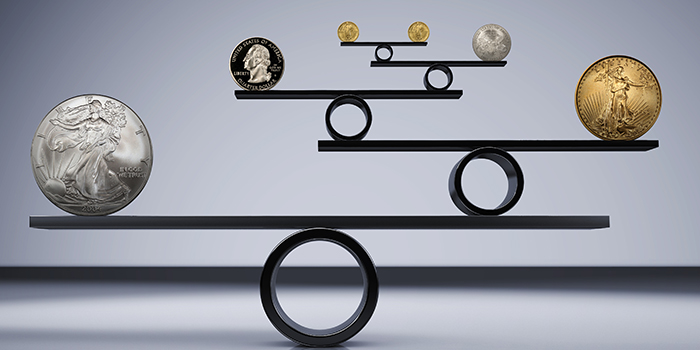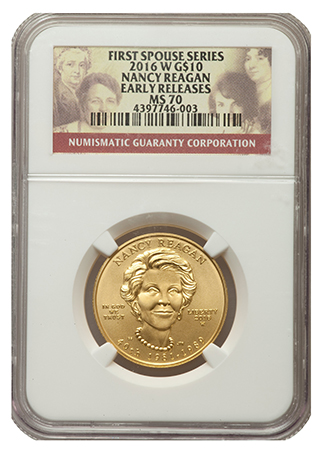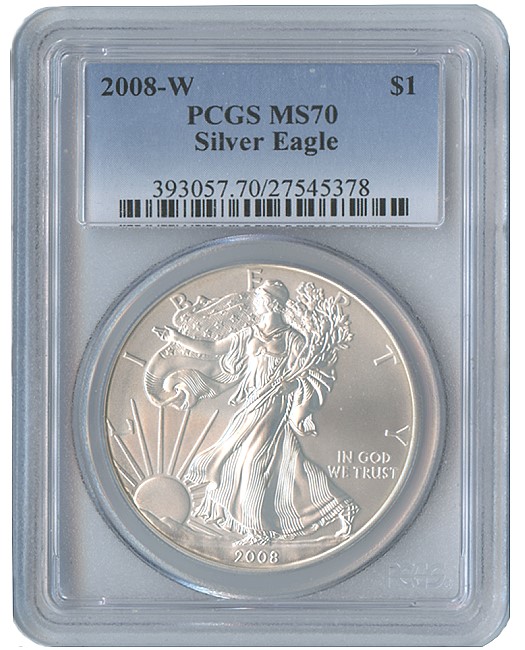
For most of numismatic history, the highest possible grade on the familiar 1-to-70 coin grading scale was an ideal to be considered rather than a realistic grade to be attained. It was a number conceived in a period where most collectors were consumed with a desire to collect what we today call “classic coins”.
NGC and PCGS, the top grading services, have never given a classic coin a 70 score, although, amazingly, a small number of coins, including a few Saint-Gaudens double eagles and Morgan dollars, have come close, grading Mint State-69.
As minting technology improved, however, “perfect” coins became possible.
PCGS gave its first MS-70 grade in 1988 to a 1987-W Constitution $5 gold commemorative,. It was a turning point for the hobby and marked a the beginning of a grand phase of development for the coin industry. Since that point, the proportion of modern coins earning 70s has increased at a staggering rate.
What, however, does a 70 mean?
How can anything be perfect?
Let’s focus on MS-70, also known as Perfect Uncirculated, although the standards for Proof-70 are similar.
 The Official American Numismatic Association Grading Standards for United States Coins, the essential book on coin grading, describes MS-70 as “The perfect coin.” It goes on to define this grade, stating:
The Official American Numismatic Association Grading Standards for United States Coins, the essential book on coin grading, describes MS-70 as “The perfect coin.” It goes on to define this grade, stating:
“No contact marks are visible under magnification. There are no noticeable hairlines, scuff marks, or defects.”
The PCGS Official Guide to Coin Grading and Counterfeit Detection offers a subtle but important change to this definition, reading:
“An MS-70 coin has no defect of any kind visible with a 5X (5-power) glass”
while NGC’s verbiage allows for a subtle difference, denoting an MS-70 as,
“A coin with no post-production imperfections at 5x magnification.”
What you should take away from reading the PCGS and NGC definitions is that an MS-70 coin does not have to possess microscopic perfection.
A coin earns a perfect score if no defects appear after careful inspection with a lens. Put another way, the MS-70 coins that you see traded every day are not necessarily perfect in an absolute sense. Instead, all a coin has to be in order to earn the 70 grade is to appear perfect during the grader’s close and well-informed review.
The market premium typically applies for any coin that passes that review and ends up in an MS-70 holder from a one of the two aforementioned grading services. A buyer, however, needs to understand a series and each coin in that series before deciding how much of a premium to pay for a perfect coin.
Close, but no Cigar
What about coins graded MS-69?
Fortunately, the information needed to understand the price difference between MS-69 and MS-70 coins is not hard to find. The NGC and PCGS price guides, available online and in their smartphone apps, show which issues graded MS-70 earn big bucks and which warrant only modest, if any, premiums.
Of course, check real world prices before paying the price guide value, which may be too low or, more often, too high compared to actual sales in the rare coin market. Price guides show relative prices (whether one coin is more valuable or less valuable than another) better than they show precise amounts.
As an example, look at the CoinWeek Price Guide for Mint State Silver Eagles, the most popular modern coins.
For early years, MS-70 Silver Eagles earn enormous premiums. A 1987 or 1990 Silver Eagle in PCGS MS-69 is worth about $35. The value in MS-70 goes up to $1,200 to $1,500 for the 1987 Silver Eagle or a whopping $5,000+ for the 1990 coin.
 PCGS has certified 88 1987 Silver Eagles as MS-70 and only six 1990 coins in Perfect Uncirculated. With hundreds of thousands of Silver Eagle collectors competing for these few coins, the upward price pressure, historically, has been intense.
PCGS has certified 88 1987 Silver Eagles as MS-70 and only six 1990 coins in Perfect Uncirculated. With hundreds of thousands of Silver Eagle collectors competing for these few coins, the upward price pressure, historically, has been intense.
As manufacturing standards tightened, more perfect coins came out of the Mint and 70s appeared more often. This had the expected consequences for the market premium of these perfect coins.
A 2007 Silver Eagle, for example, has a book value of $28 in PCGS MS-69 and about three times as much, $80 to 90, in MS-70.
You still need to pay a premium for one of the several thousand perfect coins certified so far, but that premium is now an affordable amount.
Today, the spread has tightened even more and the MS-69 and MS-70 values for 2017 Silver Eagles are $34 and $47, respectively, meaning the perfect coin and almost perfect coin differ by only a few dollars.
The Silver Eagle illustrates the MS-70 market well because it is a widely collected coin with grade sensitive buyers and because 70s exist for all dates.
Looking at other series shows that, in some cases, the perfect grade remains elusive.
Most coins made for circulation, for example, rarely or never appear in MS-70.
Bulk handling practices necessary for circulating coins mean that coins will not make their way into the hands of collectors without some small flaw. Looking at the PCGS price guide for Jefferson nickels, for example, shows only one date with a price listing for a circulation coin in MS-70. Two 1994-P coins have so far earned this perfect score. The PCGS price guide gives $5,000 as the value, but we will need to wait for a public auction to learn if the market value is higher or lower.
Similarly, no Presidential dollar has ever earned an MS-70 from PCGS, or even an MS-69.
On the other hand, PCGS and NGC grade recent U.S. commemorative gold coins as MS-70 at a rate of about 80%. That is, the great majority of these coins earn perfect scores.
When I bought five 2017-W Boys Town $5 uncirculated gold coins as a speculation, for example, I kept the four that I thought would grade 70 and sent the one slightly imperfect coin back for a refund.
Other recent U.S. Mint gold collector coins, such as First Spouse half ounce coins or 2016 100th anniversary gold Mercury dimes, also usually grade 70.
Although 70s are common, the market still values the grade and certified MS-70 examples can earn 30-50% more than uncertified coins. Keep in mind, there is a cost to having your coins graded and some of the market premium for 70s covers the cost of encapsulation.





I have a beautiful 2005 California Denver Mint Mark quarter that I believe would reach a mint State 69 if not 70